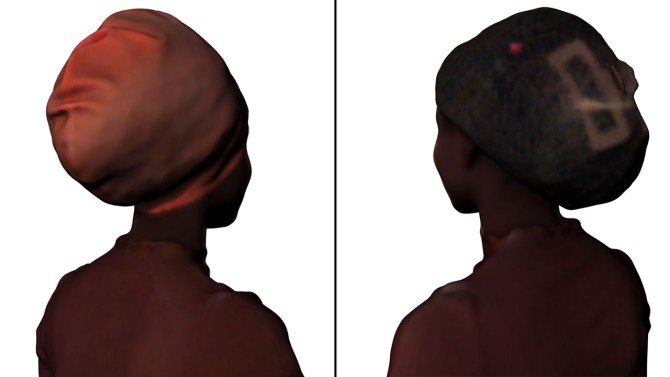
Inventing a swim cap for people of color and others with diverse hair types is the goal of entrepreneur Saira Patel, who is working with the Fashion and Body Tech Lab in the College of Human Ecology to expand access to swimming for everyone.
Building a better swim cap for people of color
By Susan Kelley, Cornell Chronicle
Entrepreneur Saira Patel has always been reluctant to jump into a pool or an ocean because of the hassle it creates with her hair.
“I don’t want to deal with all of the pain and suffering that follows,” said Patel. “When diverse hair types get wet, it’s not as easy to restyle or maintain the hair. It gets very tangled, it breaks, it dries out and it’s just very delicate and requires very labor-intensive styling.”
Patel, of New York City, is working with the Fashion and Body Tech Lab in the College of Human Ecology (CHE) to invent a swim cap that will keep hair dry even when submerged underwater. Her company, rsspcts, aims to expand access to swimming and water recreation for people of color and others.
The issue involves more than just appearance, she said. Black people drown at a rate 1.4 times the rate for whites, according to the Centers for Disease Control and Prevention. Disparities were greatest in swimming pools, with drowning rates among Black children ages 5–19 5.5 times higher than those among whites in the same age group. And this disparity was greatest at ages 11–12 years; at these ages, Black children drown in swimming pools at 10 times the rate of whites, according to the CDC.
“Swimming is an important survival skill,” Patel said. “More people of color might consider swimming, recreationally or for exercise, if they didn’t have to worry about figuring out how to get their hair back together for three hours or spending more money on hair care.”
Fatma Baytar, Ph.D. ’11, assistant professor of human centered design in CHE, and two graduate students gathered data for Patel by scanning a 360-degree view of study participants’ heads, hairlines, hair volume, head circumference and surface area, and more.
“As we’re scanning participants, we would like to understand hairline shapes, as well as some anthropometrics related to head shapes, so we can provide her with some measurements that she can consider when she finalizes her design,” Baytar said. “We’re empowering women by helping to design something they will wear and feel comfortable in.”
The work all comes down to promoting inclusivity and well-being, Baytar said. “We take measurements and use these numbers to improve sizing, so we can create better size charts for mass production,” she said. “Everybody is different, and capturing the individual data helps promote inclusivity.”
Patel found the Fashion and Body Tech Lab through FuzeHub, a New York state program that connects entrepreneurs to leaders in manufacturing innovation.
FuzeHub led her to John Sinnott, industrial programs manager at the Cornell Center for Materials Research, a FuzeHub partner since the program’s beginning. Sinnott is a member of the FuzeHub solutions team, which fielded Patel’s query. “This project was one that I knew Cornell could handle,” Sinnott said. “And I knew Fatma and the Fashion and Body Tech Lab; I thought that would be a great initial test starting point for Saira.”
And that led Patel to a CCMR JumpStart program, which helps small businesses in New York state solve identifiable problems related to materials. Patel had first worked with researchers from Rensselaer Polytechnic Institute, who tested forces and other measurements on Styrofoam heads used as wig mannequins.
But then she needed measurement data from human heads, Sinnott said. “If anybody can fix this problem, Cornell can,” Sinnott said. “People come to Cornell to fix the hard problems. That’s what we’re really good at.”
The Cornell researchers asked participants to arrange their hair as they would before putting on a swim cap – in a ponytail, for example, or a bun at the nape of the neck or at the top of the head. Where the volume of hair is concentrated is important, said Yoon Yang, M.A. ’22, a doctoral student in the field of human-centered design, who conducts the scans. “The shape of the cap matters, because it determines how much the cap extends in which part. So for example, you might not need a lot of space at the forehead or the back.” Also helping with the project is Ivania Rivera, M.S. ’24, a master’s student in the field of design tech at Cornell Tech.
Added Baytar: “The whole idea is to identify the shapes – where volume is going to be.”
They scan the participants in three conditions: bare-headed, wearing a mesh swim cap and wearing a thin nylon cap normally worn under a wig.
Once they capture the scans of the hairline and head, they can flatten the 3D images into two-dimensional shapes that can then be translated into patterns, Baytar said. “That will help a manufacturer with grading, creating smaller sizes, bigger sizes.”
“I want everyone to feel that they’re not avoiding any of the activities they want to participate in because of some discomfort with the tools they’re using,” Yang said.
Patel found in her research that people of color and others who want to keep their hair dry have only a few options. They can cut their hair short and keep it natural. They can braid their hair in microbraids, cornrows or other protective styles – but that can take three to six hours, cost from $100 to $600, and last only for two weeks to three months.
Although she’s designing the cap for people of color, she’s found in customer discovery research that white parents of biracial children and Asian people are also interested in the cap.
“We’re trying to effect social change,” Patel said. “We’re trying to get more people of color to enjoy the benefits of swimming. We’re trying to raise awareness about this issue and the barriers of entry into swimming. And this partnership will help accelerate the design.”
Media Contact
Get Cornell news delivered right to your inbox.
Subscribe




